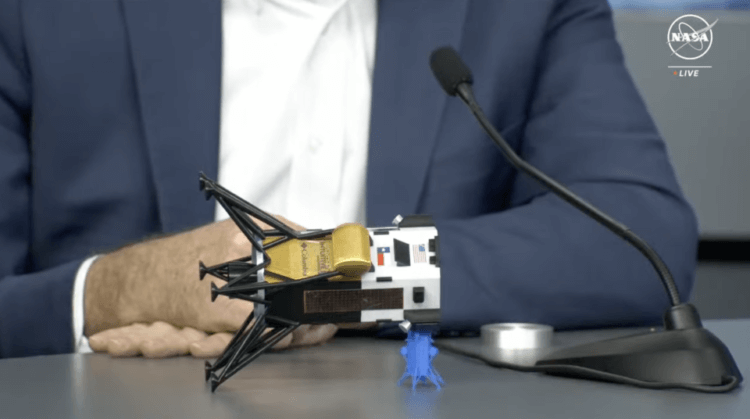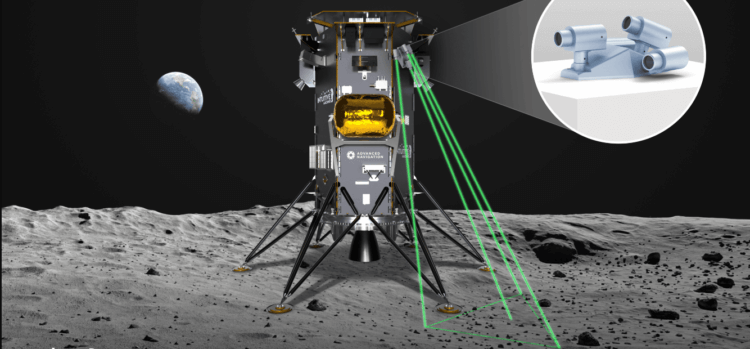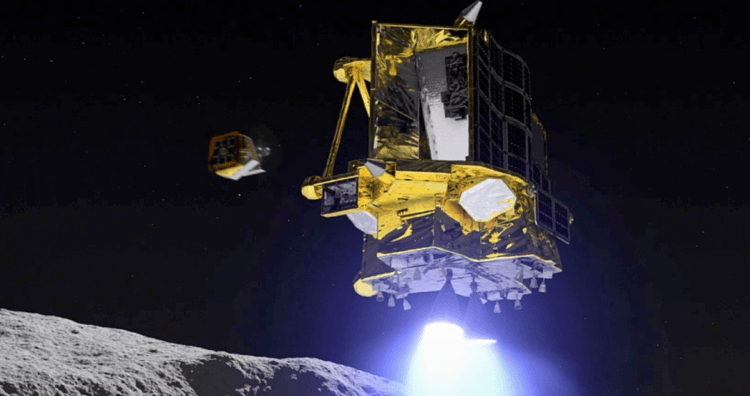The Odyssey lunar lander landed on the surface of the Earth's natural satellite on February 23, and this event marked the return of Americans to the Moon 50 years after the completion of the Apollo mission. We previously reported that serious technical problems arose during landing that jeopardized the entire mission. According to the latest data, the mission landing module did fall. For this reason, since the landing of the Odyssey on the moon, he has not sent a single photograph to Earth. The only photo was taken at the moment of landing of the device. What really happened to him and can the mission be called a failure?

Spacecraft «Odyssey» during landing on the Moon, he fell on his side and, by a lucky chance, avoided a complete crash
What happened to the Odyssey apparatus
According to Steve Altemus, chief executive of Intuitive Machines, the lander is in contact, alive and at or near the planned landing site. However, during landing the device fell and is currently lying on its side. For this reason, its antennas are not pointed at the Earth, and therefore the ability to transmit data is severely limited.
Engineers at Intuitive Machines are working to get more data from the spacecraft. But we can already assume that many of the tasks that were set by NASA will not be completed in the end. However, the mission could have ended with a complete crash of the spacecraft, and a happy accident saved it from this.

Due to the horizontal position of the Odyssey spacecraft, its antennas are not directed towards the Earth
What saved the Odyssey from complete collapse
As we have already told, during the flight of the spacecraft «Odyssey» Several technical problems arose. Because of one of them, the lander began landing several hours later than planned. This was due to the fact that the device had to enter a circular orbit of the Moon at an altitude of 62 miles (about 100 km) above the surface of the satellite. But due to trajectory inaccuracies, he ended up in an elliptical orbit. As a result, we had to start the engine and change the trajectory in order to move to the required orbit.
After the necessary actions, “Odysseus” began landing. To calculate the distance from the vehicle to the lunar surface, controllers turned on laser rangefinders (LiDAR), which send laser pulses to the Moon. It was they who put the entire mission in jeopardy. As it turned out, the lasers did not work. There was almost no chance of making a successful landing without a laser rangefinder.
The operators began to think about how to solve the problem. Fortunately, there was such an opportunity, since on board was NASA’s experimental instrument “Navigation Doppler Lidar”, which has three beams that allow you to control not only the altitude, but also the speed of the spacecraft during descent. However, engineers needed to change the software so that the NASA instrument would transmit its data to the onboard guidance, navigation and control computer.

The device could have crashed due to faulty laser rangefinders
As the engineers themselves say, in normal circumstances the creation of such software would have taken a month. However, they were able to solve the problem in an hour and a half. But even this extra time they had was only due to the fact that the device was in the wrong orbit and the landing was delayed. If the calculation had turned out to be accurate, and the spacecraft immediately went into a circular orbit, it would probably have crashed on the surface of the Moon, since the malfunction would have been discovered much later.
Why did the spacecraft flip over
To run the new software, engineers had to reboot the on-board computer. This was another problem, since the ship would have to be left without control for some time. The dispatchers found a way to do this so as not to doom the device to death. However, something still went wrong. The navigation system showed that «Odysseus» descends faster than necessary and moves sideways rather than vertically.

The Japanese spacecraft also turned over during landing on the Moon in January
Most likely due to lateral movement one from the supports caught on the surface, causing the spacecraft to capsize. Perhaps one of the six landing gear supports of the device broke at that moment. It must be said that the Japanese landing module also turned over during landing in January of this year. By the way, it is still in working order.
Follow the link to our ZEN CHANNEL. We've got a lot of interesting, exciting science content for you.
Intuitive Machines engineers are continuing to work to improve communications with Odyssey. Perhaps this task will ultimately be solved, but for now the mission cannot be called a success, although it was not a complete failure either.